After having had a good time in our hammock at the 4000 Islands in southern Laos, we headed to Pakse for a new scooter loop, this time on the Bolaven Plateau. What is exceptional about it? In fact, there are spectacular waterfalls but also coffee plantations, great swimming spots and beautiful nature spots. Are you ready? Follow the guide to The Pakse Loop!
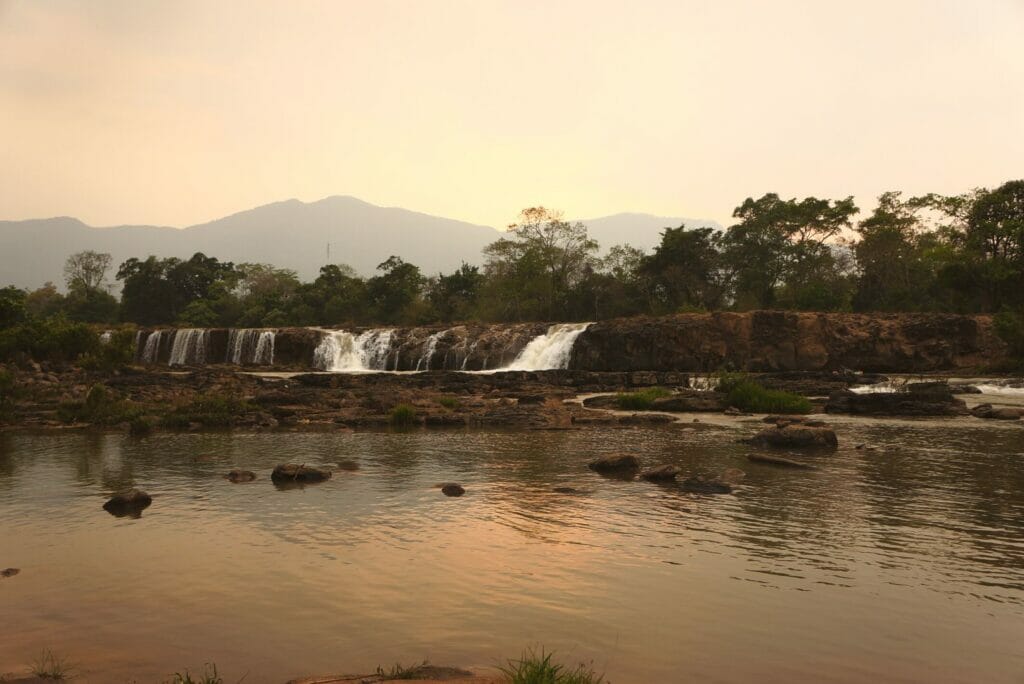
- Reaching Pakse
- Hotels in Pakse
- Rent a scooter in Pakse to do the Bolaven Plateau Loop
- Map of the Bolaven Plateau Loop
- Day 1: From Pakse to Tad Lo (85 km)
- Day 2: Around Tad Lo
- Day 3: From Tad Lo to Tad Tayicseua (125 km)
- Day 4: From Tad Tayicseua to Pakse (95 km)
- The useful information to read before making the Bolaven Plateau Loop
- The Thakhek Loop or the Bolaven Plateau Loop?
We took this trip in 2014, but the article was completely revised and updated in February 2023. If you see any price changes or have additional information that might be relevant, please feel free to leave us a comment!
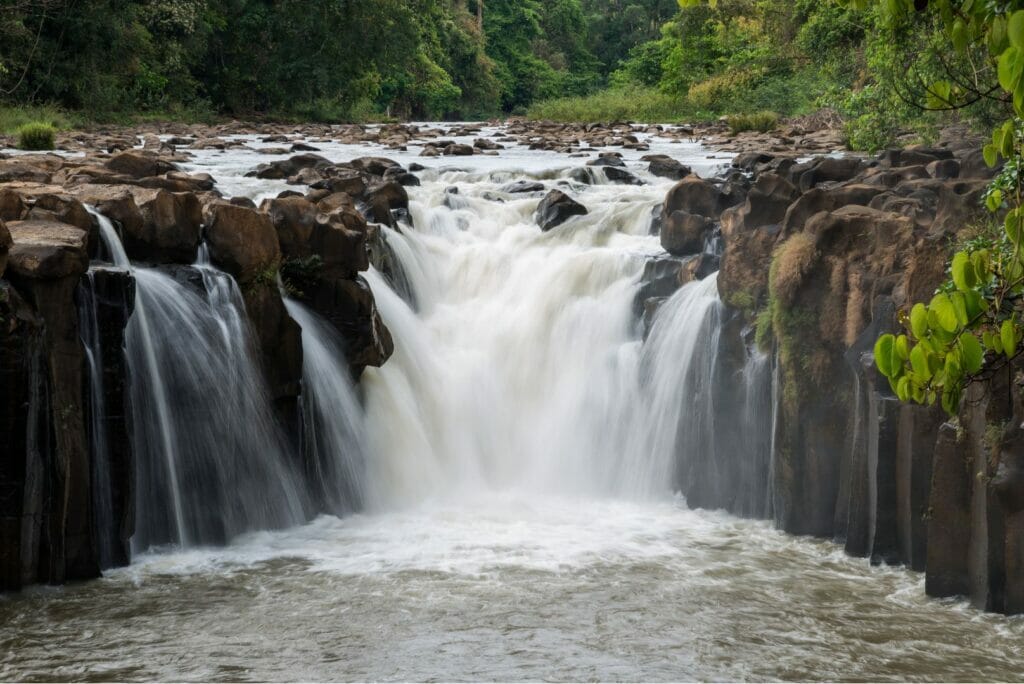
Reaching Pakse
In southern Laos, Pakse is the gateway to the Bolaven Plateau. The easiest way is to reach the city during the day and leave early the next day.
By bus
As you know, the bus is the most common means of transportation to travel throughout Southeast Asia. Pakse is the 3rd largest city in Laos, so you are bound to find a bus that goes there from wherever you are! Chances are you will arrive at the southern terminal of Pakse, also called the 8 km Bus Terminal or at the Chitpasong terminal in the center of the city.
- From Vientiane: Are you ready to spend 12 hours on a night bus 😉 ? Well, that’s fine but you’ll miss the Thakhek Loop! Departures are often scheduled at 8 p.m. to arrive (almost fresh) in Pakse at 8 a.m. for a price around 400 000 kips.
- From Thakhek: Many accommodations offer to book tickets to Pakse including tuk-tuk transportation from your hotel to the Thakhek bus station (Inter-Provincial Bus Station). Otherwise, you can always buy your tickets directly at the different bus stations as it is impossible online. The journey takes at least 6 hours.
- From the 4000 Islands: The tickets combine the ferry crossing from Don Det or Don Khone to Nakasong and the bus ride to Pakse. The price is about 220 000 kips.
- From Siem Reap: A minibus will take you from Siem Reap to Pakse in just under 12 hours for 800 000 kips.
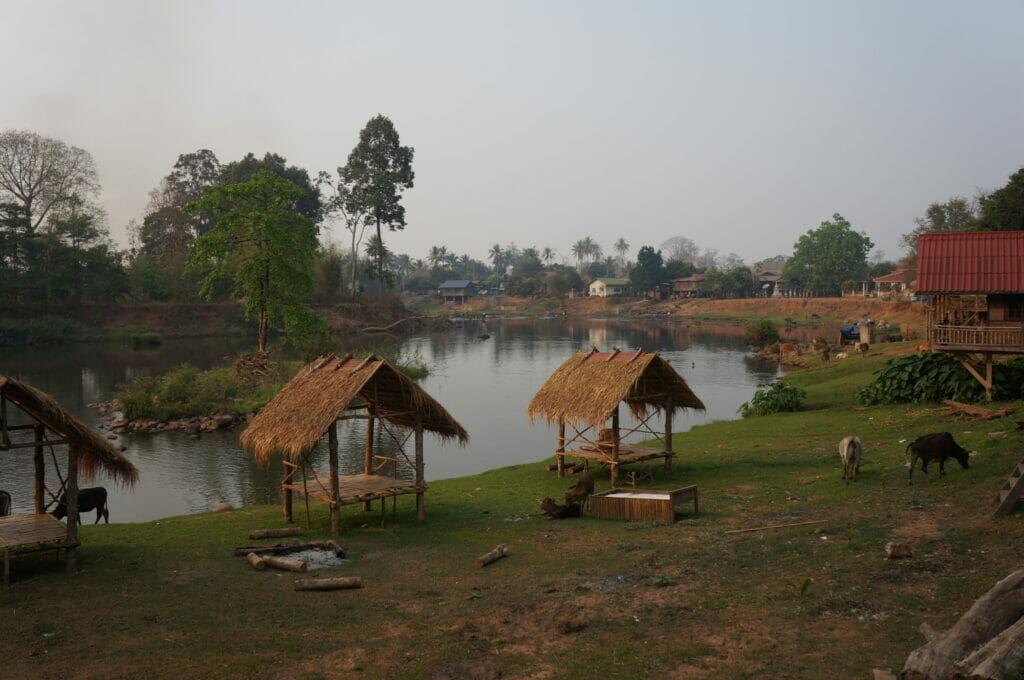
By plane
This is the fastest way to travel between major cities but tickets in Laos are quite expensive for a short distances. To get from point A to point B, you may find it faster to take the bus than to make a stopover or combine the plane and the bus… Pakse International Airport is only 3 km from downtown Pakse.
- From Vientiane: prices are around 2 million kips (about 110 euros) for a 1-hour flight.
- From Siem Reap: tickets cost an average of 3 million kips for a 1-hour flight. Please note that there are no direct flights every day.
Hotels in Pakse
One thing is sure, you will have no trouble finding good accommodation in Pakse! The city is an unavoidable stopover and you will meet a lot of tourists either in transit for the 4000 Islands or the north of Laos or ready to make the Pakse Loop by motorbike. The hotels fill up quickly but you will inevitably find a guesthouse or a youth hostel that will welcome you for the night before starting the loop on the Bolaven plateau! One of the best values for money is at the Sanga Hostel, 7 $ a night in a new hostel, in the center and close to everything.
No hostel for us this time… Yes, we changed the range but we have a good reason! Once arrived, we thought to rent a scooter and leave on the road, our hair in the wind. But it is well known, in travel, it is sometimes necessary to make with some small mishaps. This time, it’s a nasty turista that nailed Benoit to the bed for 3 days! So we stayed at Alisa Guesthouse to be quieter.
The city itself is not very interesting to visit but Champasak has its say, about 40 km south of Pakse. The main attraction of Champasak is definitely its temples, especially Wat Phu (or Vat Phou), a temple listed as a UNESCO World Heritage Site and older than those of Angkor! To get there, it takes about 1 hour, either by scooter or by public transport.The entrance fee is 50 000 kips per person. For more information, we advise you to read the article dedicated to Wat Phu on Sarah’s blog.
Before returning your motorbike after the loop, it may be worth it to take a last little ride a little further south 😉.
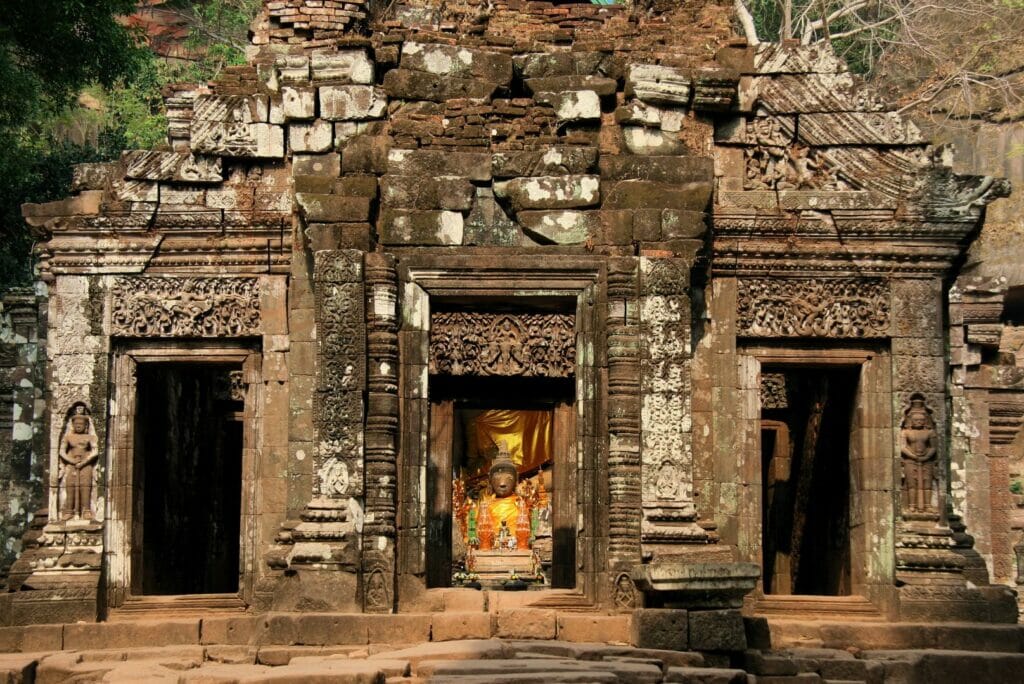
This article contains affiliate links to partner sites. When you use our links to book accommodation, a car, or an activity, you don’t pay anything extra, but we get a small commission. This helps us to offer you free, independent, and ad-free content. Thank you for your support!
Rent a scooter in Pakse to do the Bolaven Plateau Loop
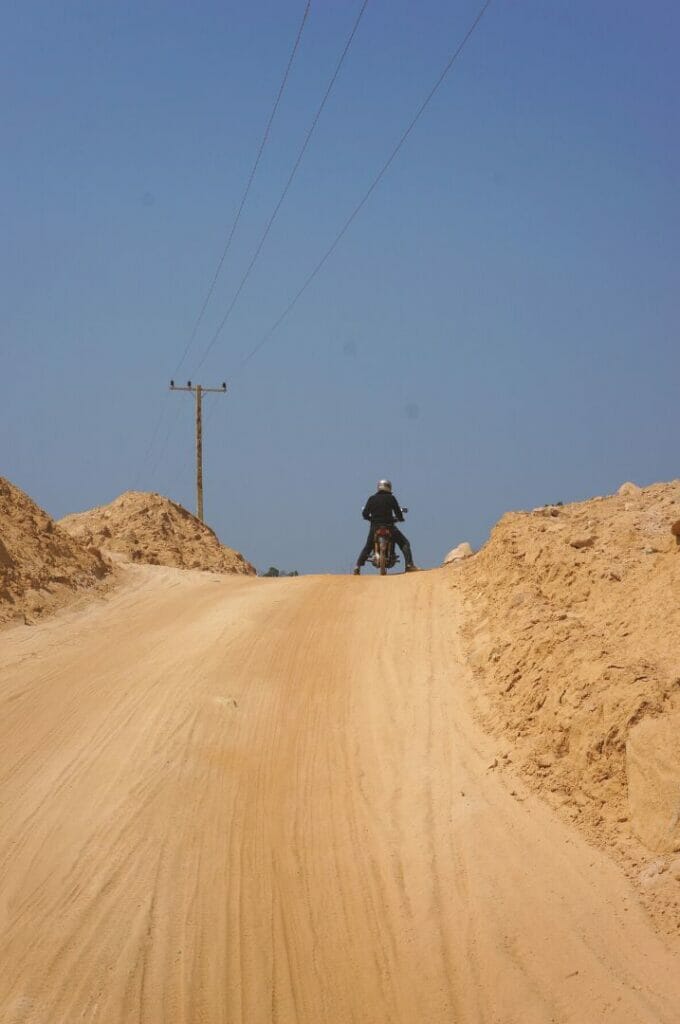
How can we not talk about Miss Noy Motorbike and Yves alias The Belgian Guy when we talk about scooter rental in Pakse? Yves does a briefing every day at 6 p.m. to give you all the information about the Bolaven Plateau loop.
Little advice: contact them 1 or 2 days before the loop to be sure to have a bike. As the rental is unlimited, which means that you can come back whenever you want, you might be on the waiting list, without being sure to get a precious bike… If you have any problem on the road, call them, and they will have the solution. You can even leave your big backpack there and have laundry done during your loop.
The rental is around 100 000 kips per day for a semi-automatic. By the way, we recommend this type of scooter, you will have more control over the tracks that lead to the waterfalls. On the other hand, we really advise you not to rent a new and expensive scooter… You may have less chance to have a mechanical problem, but be aware that most of the repairs in Laos cost maximum 20 000 kips. To ride safely on the Bolaven Plateau, do not forget your international license and we refer you to this article with all our motorcycle/scooter tips!
If you don’t get any luck at Miss Noy’s, Alisa Guesthouse is a good alternative to rent a scooter.
If you are not a two-wheeler lover, don’t worry, it is still possible to do a day trip and enjoy its natural attractions! Several agencies and motorcycle rental companies (including Miss Noy) offer tuk-tuk tours. Ask around town, it would still be a shame to skip the Pakse Loop and its impressive waterfalls 😉.
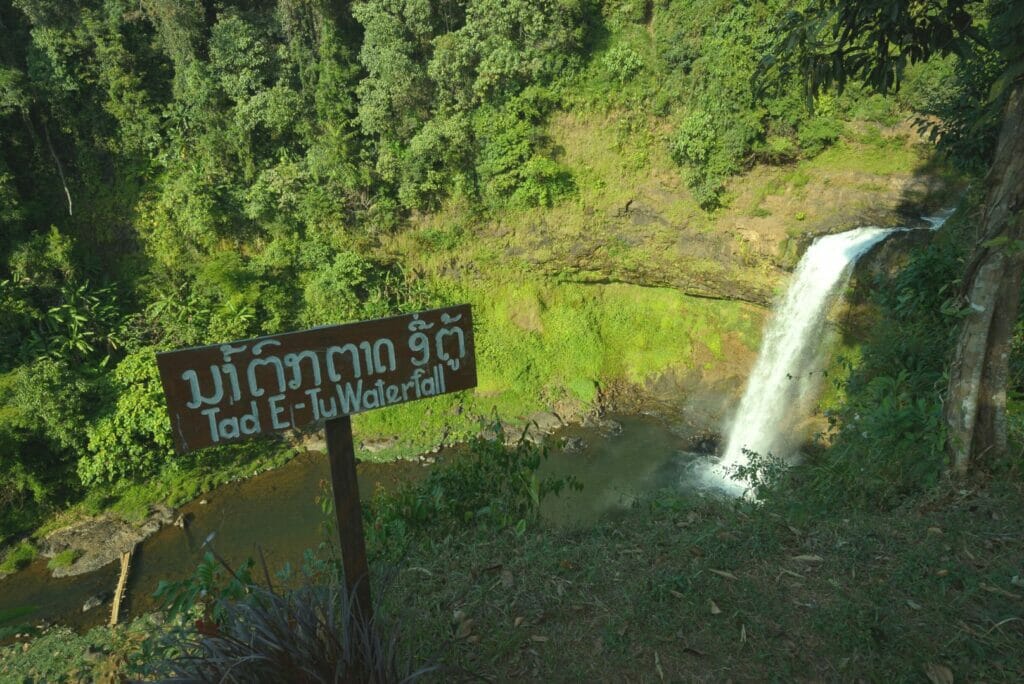
Map of the Bolaven Plateau Loop
But why is this plateau called this? In fact, it comes from the Laven, an ancient ethnic group that dominated the region. Then, the migrations of the populations and the marriages mixed the ethnic minorities… For the small anecdote, the French annexed the plateau at the end of the 19th century and it is them who planted coffee there afterward. Thanks to their transmission of agricultural techniques, the region became a land suitable for cultivation.
The Bolaven Plateau was also seriously affected during the Vietnam War. Indeed, it was a strategic place for the Americans as well as for the North Vietnamese and it was one of the most bombed areas…
So, as usual, we put a small homemade map to help you in your itinerary if you want to try the experience.
The small loop is 200 km long and passes through Tad Lo, Thateng, and Paksong before returning to Pakse. The big loop is a little more than 300 km long and adds roughly 100 km passing through the villages of Sekong and Houay Kong between Thateng and Paksong.
As Ben absolutely wanted to see the Tad Katamtok waterfall (supposed to be the most beautiful of all), we started the big loop of the Bolaven Plateau. Conclusion: no regret! The most beautiful places are on the big one, in the south and southeast of the loop.
Day 1: From Pakse to Tad Lo (85 km)
This first day on the Bolaven Plateau is rather quiet with less than 100 km by motorbike. On the road, there are 4 notable stops with 2 waterfalls, a coffee farm and a temple lost in the forest.
2 waterfalls, 2 atmospheres
The first waterfall, Tad Pha Suam (or Tad Phasouam), is very easy to find. Well, it is pretty but far from being transcendent. The infrastructures around it are abandoned, which does not help to appreciate the place… The entrance is free.
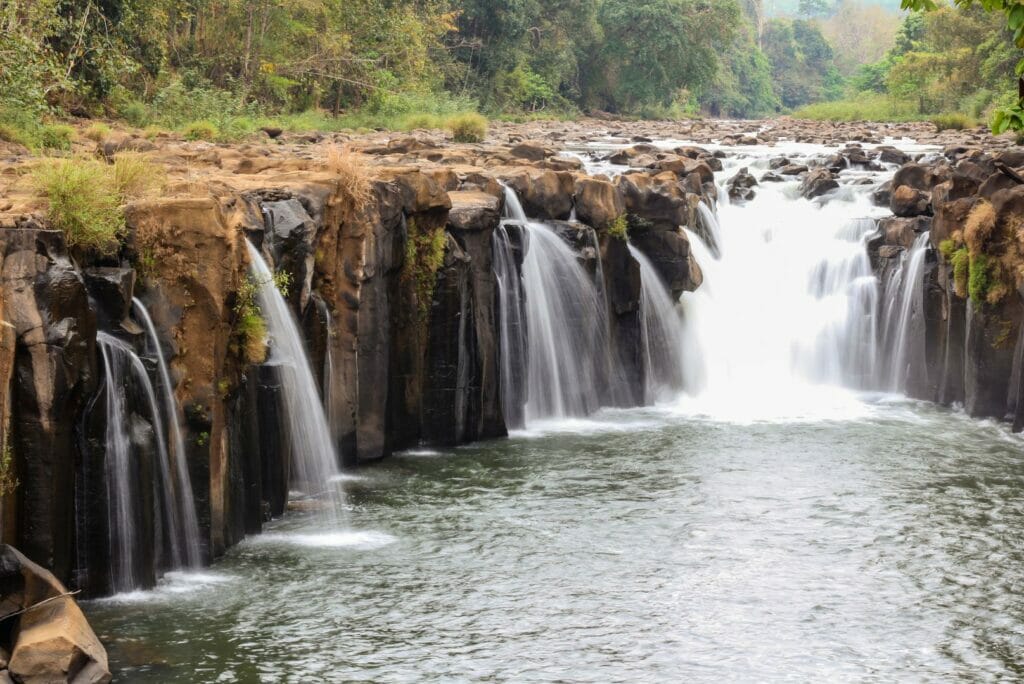
Honestly, the main attraction of this first day was for us the Tad Champee (or Tad Champi) waterfall. Beware, two waterfalls have this name on the Pakse Loop! The second one is located in the Paksong – Pakse section. Here, we are talking about the first one, on the road to Tad Lo. Besides, like Pha Suam, it is located on the Vang Ngao River. On the other hand, it is a little more difficult to reach and much less touristy. 2 km after the first waterfall on the main road, turn left (it is indicated in principle) and drive for 10 km. The exact location is indicated on the loop map.
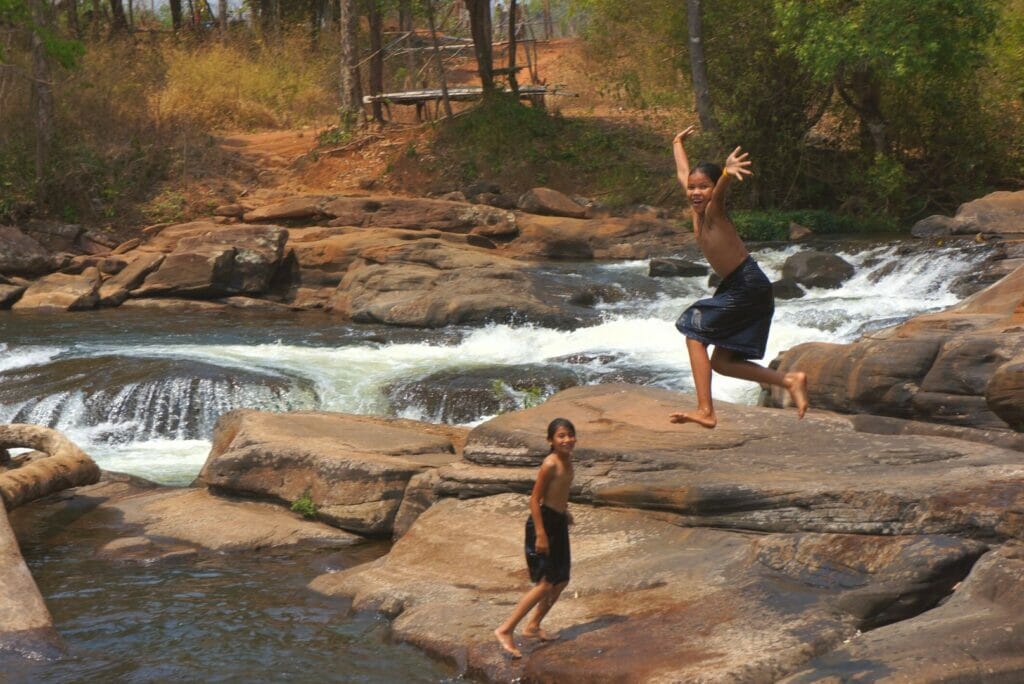
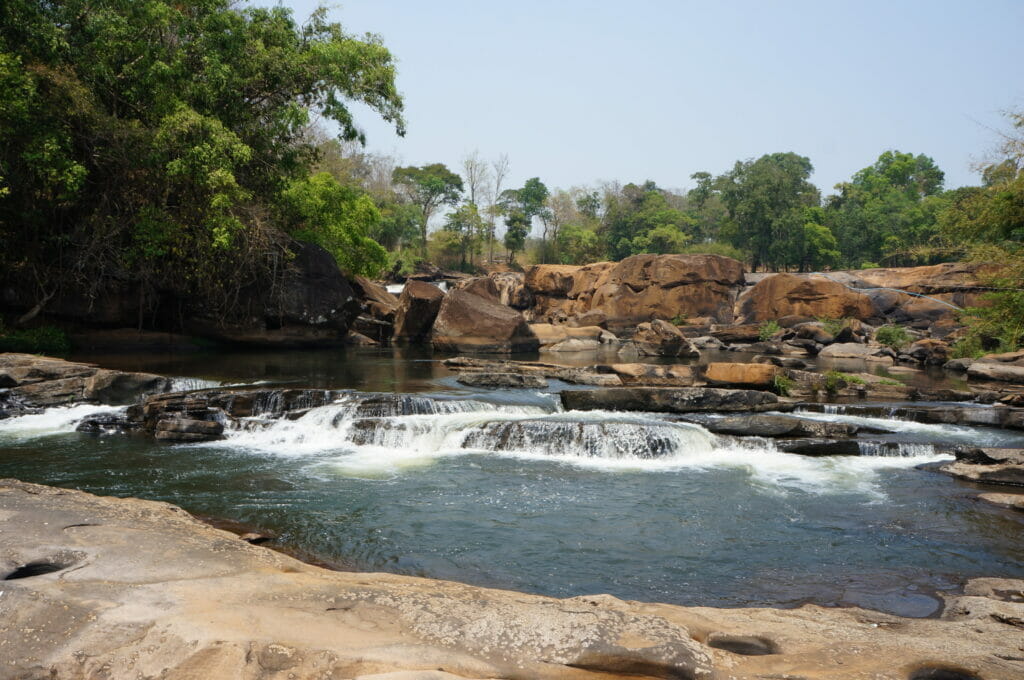
Well, the track is not great but it is worth it! We arrived in a charming place where there was absolutely nobody except a group of small girls who refreshed themselves there. And the ultimate must for me, it is this super spot to jump in the water and to make go up a little the adrenalin. We stayed there for 3-4 hours… The good life!
Laotian coffee tasting
As it was getting late, we just had time to stop at Mr. Vieng Coffee + Homestay for a delicious Lao coffee tasting. If you have time (that is if you haven’t spent 3 hours diving into a waterfall!), Mr. Vieng and his family will be happy to show you their (organic) plantations and share their knowledge about these small fruits. You can even eat there and spend the night.
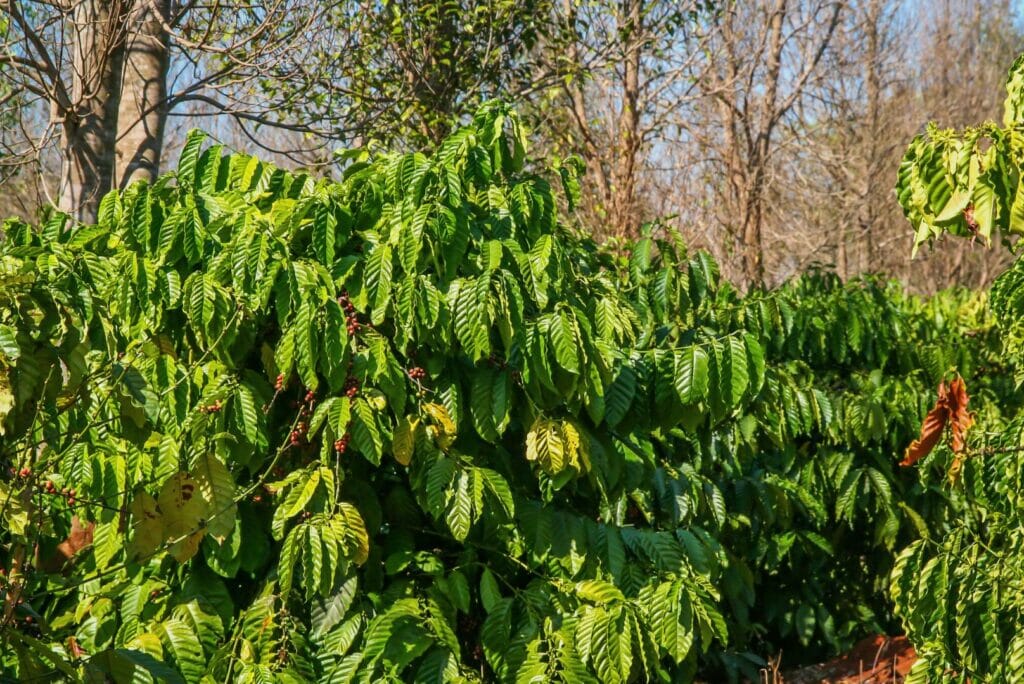
Wat Pa or the small temple lost in the forest
About fifteen kilometers from the coffee plantation of Mr. Vieng, take the dirt road on the right. After 1 km, you will arrive at Wat Pa temple. There you will see an imposing Buddha statue lost between magnificent hundred-year-old trees and several altars spread in the lush forest. The access is free. In short, it is an opportunity to stop for 10 minutes and soak up the peaceful atmosphere of this sacred place.
If you prefer to go further on your loop itinerary and sleep in Tad Lo village rather than at Mr. Vieng’s place, you will find plenty of guesthouses there, each one nicer than the other. For backpackers, Mama Pap and her pancakes are well known and if you want a little more privacy, Fandee Island offers cabins with a view of the lake.
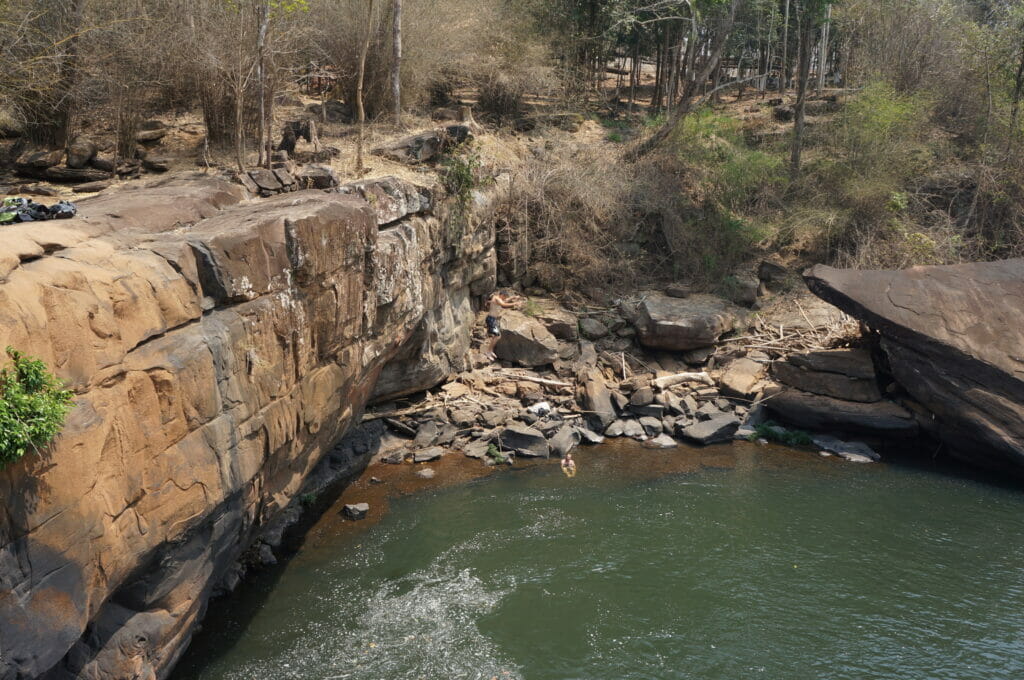
Day 2: Around Tad Lo
Tad Lo is a charming little village where it is good to relax and bathe around the waterfall of the same name. In fact, we met several travelers who had been there for several weeks and who simply appreciated the calm of the place. To tell the truth, we made the tour in one day and it was enough for us. But to each his own as they say 😉.
Tad Lo and Tad Hang waterfalls
These two beautiful waterfalls are located on the Tad Lo River running through the village. No matter if you are on one side or the other of the stream, you can cross on small bridges present in front of each waterfall and make this loop on foot. (OK, for the rest of the day, it’s still better to be on the right side, on the village side) More touristic, Tad Hang is a nice series of lots of small waterfalls while in the south, Tad Lo is more powerful and more intimate. You can swim there and many locals come there at the end of the day. Both are free.
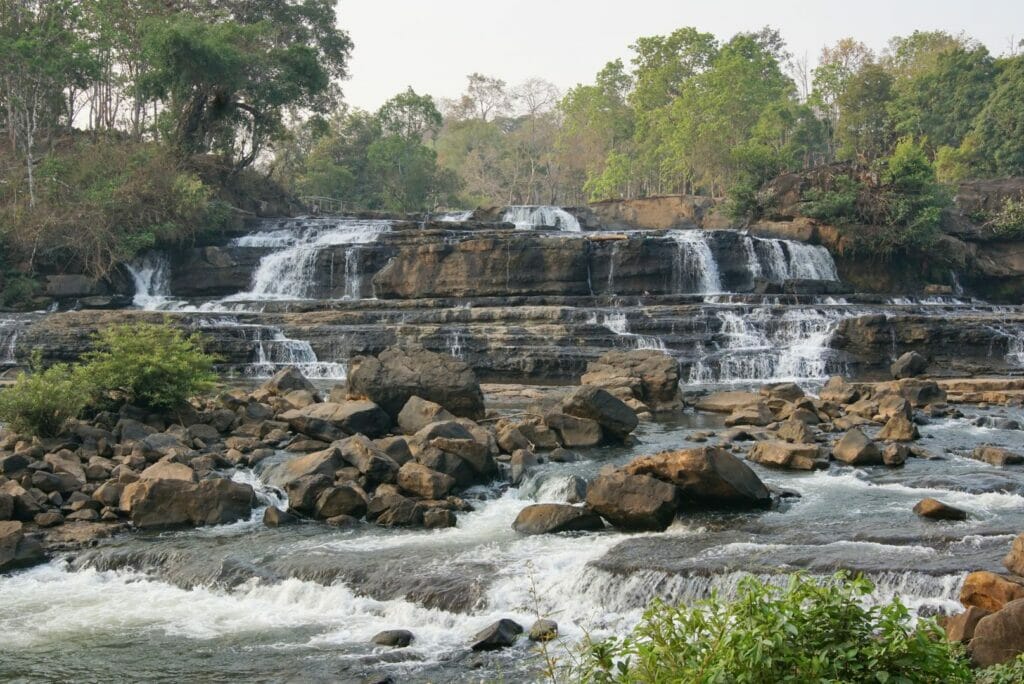
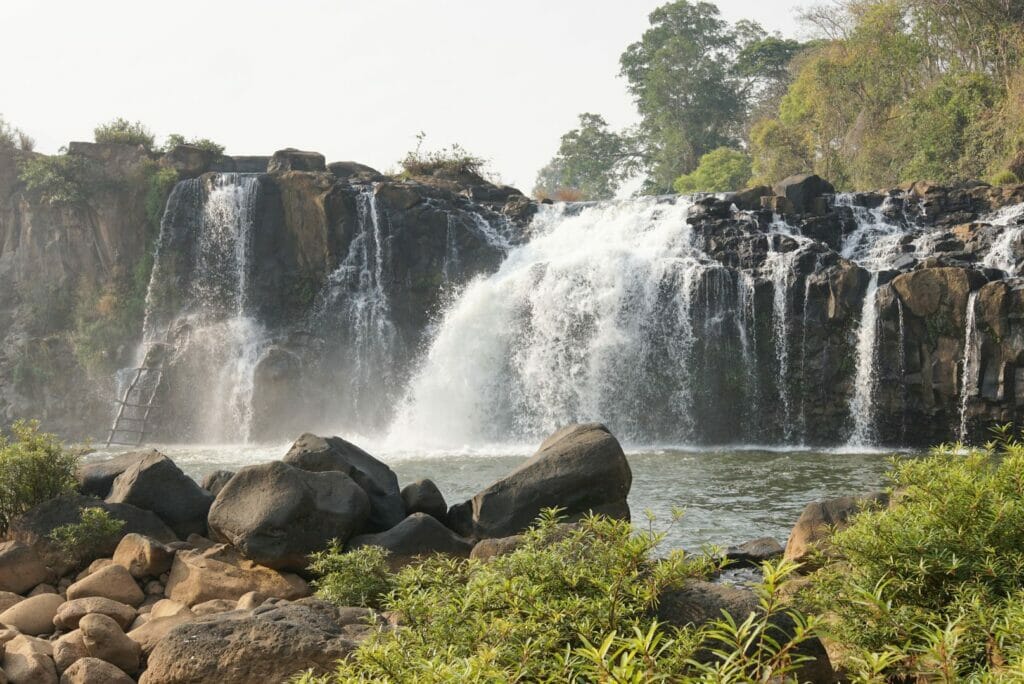
You will hear or read that at Tad Lo, it is possible to see an elephant bath. Yes, it is true but the two unfortunate pachyderms are tied up all day long and are only “freed” to take a (forced) bath in the river and entertain the tourists. We had already talked about elephant sanctuaries in Southeast Asia here and to make it short, these animals are tortured to be domesticated… We also refer you to this article which deals with the condition of these mammals. In short, you will have understood, we strongly advise you against this “activity”.
The Tad Soung waterfall
For this second day of the loop, we also advise you to take a look at Tad Soung. Unfortunately for us, there was very little water during our passage in the dry season. If you are in the rainy season, no doubt that it must be worth it! The water flows from a cliff about 50 meters high and the view is completely clear of the surroundings.
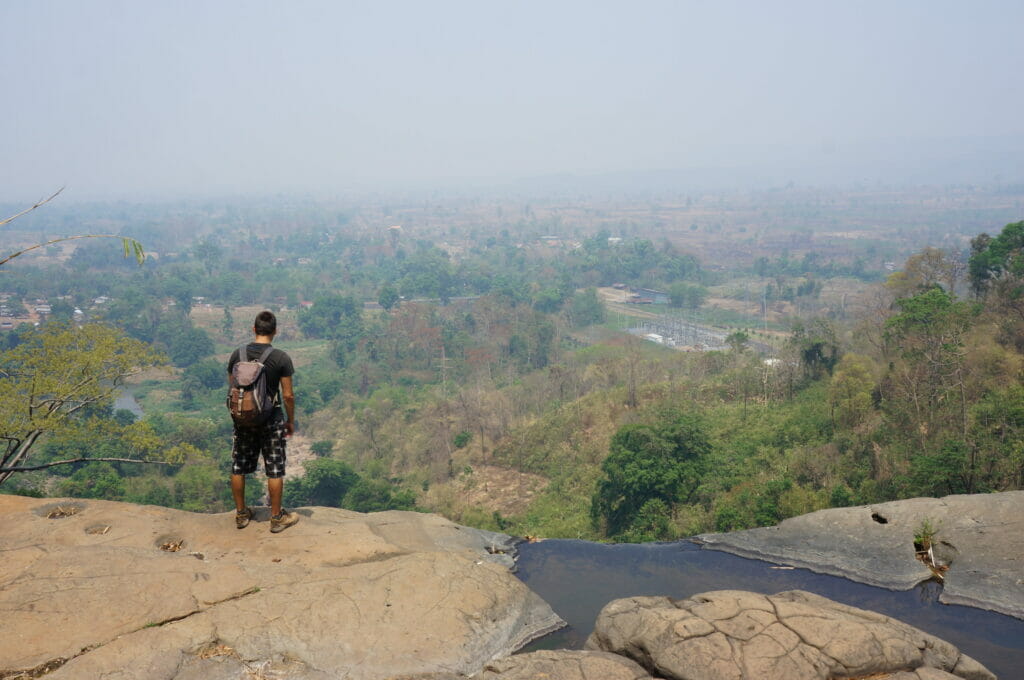
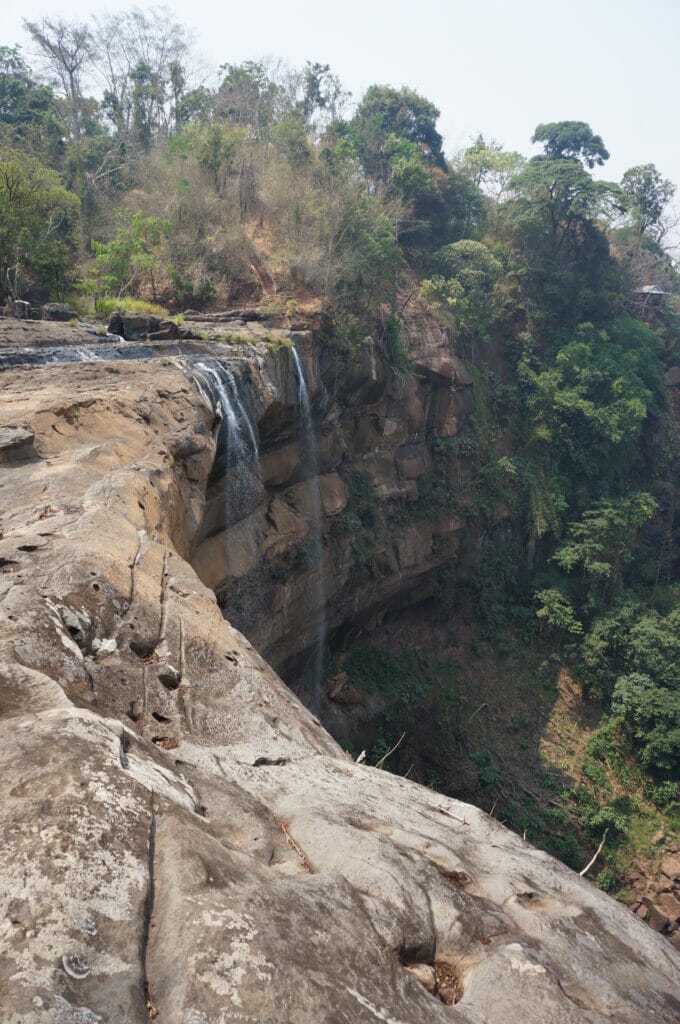
To get there, ride along the river for 3 km south of Tad Lo Falls. At the dam, turn right and cross the bridge. You will arrive at a hamlet (Ban Tadsung), cross it and continue, you will see the waterfall on your left in the distance. After 5 km, pass the last hamlet (Sanim-Nai) and park your scooter for 5000 kips. There, several signs show you the different viewpoints on the surroundings and the waterfall.
For this second night on the Bolaven Plateau, you can choose to stay in Tad Lo or move a little further on your itinerary. This could be an excuse to spend a second night at Mama Pap’s or to stay at Fandee Island facing the lake.
Further on, the village of the Katu ethnic group, Kok Phoung Tai, offers a total immersion in Lao life at Captain Hook or Somphone. The price for one night is about 100 000 kips with dinner and breakfast included, prepared by the family.
Day 3: From Tad Lo to Tad Tayicseua (125 km)
This third day on the Bolaven Plateau was quite busy with traditions, culture(s) and waterfalls of course!
Cultural visits
No matter where you spent the night, we recommend a visit to the Katu village, Kok Phoung Tai, with Captain Hook or Somphone. Both of them have hundreds of anecdotes about the life of this ethnic group and know all the secrets of the different cultures of the area! For your information, at Captain Hook’s, the tours are scheduled at 9.30 a.m. or 1.30 p.m. for 20 000 kips and at Somphone’s, they take place all day long. This is also another spot where you can enjoy delicious Lao coffee. By the way, we hope you like coffee, we find it all along the loop!
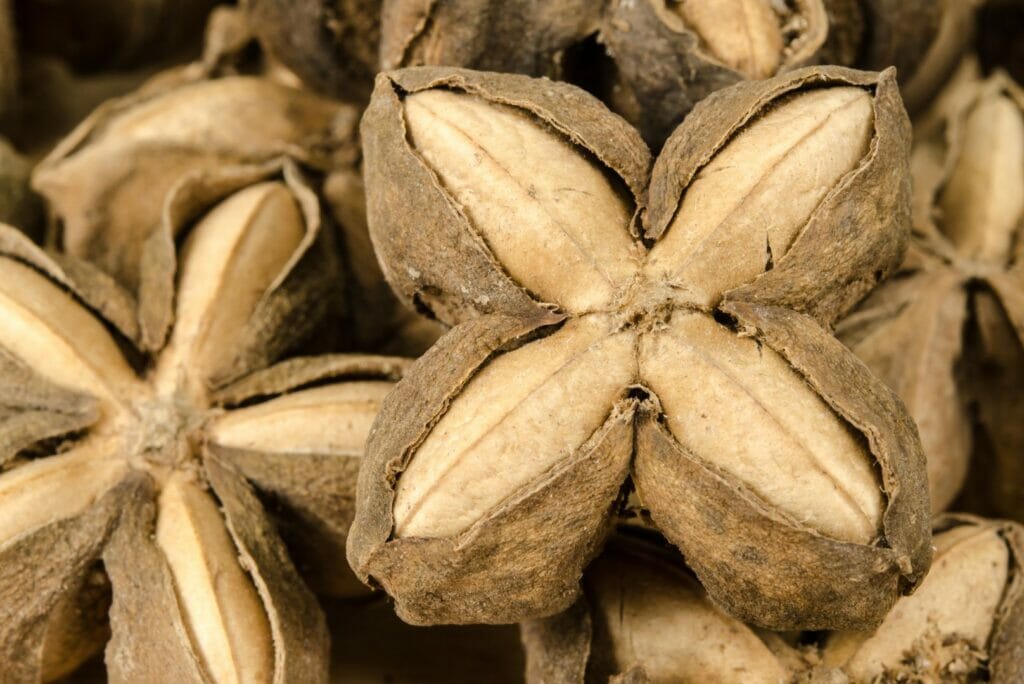
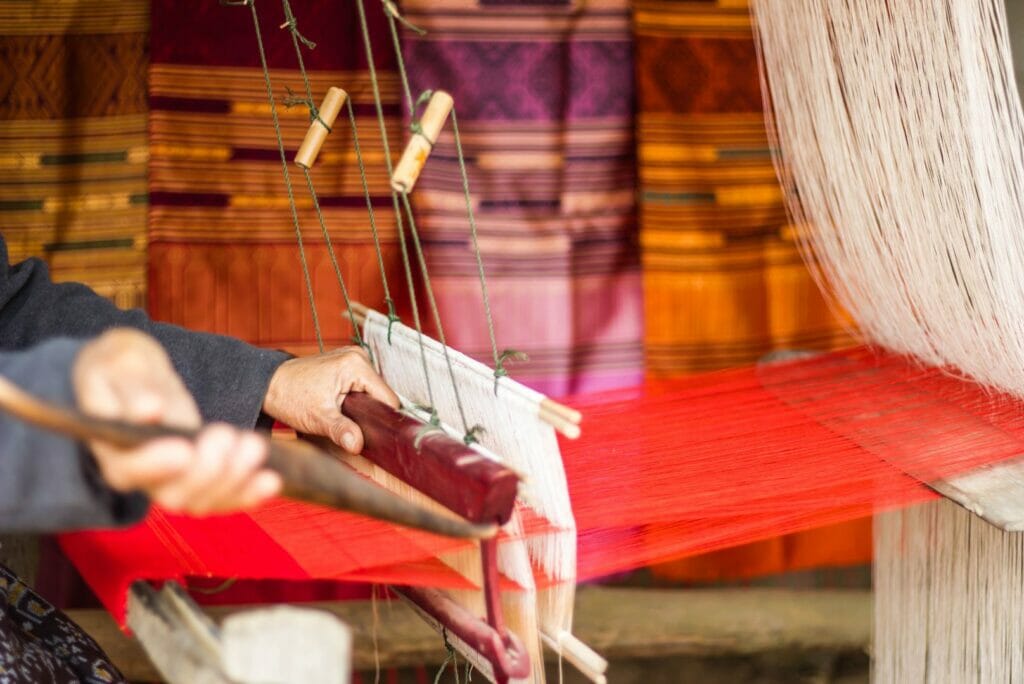
9 km east of Thateng, we also advise you to visit Maï Savanh Lao, a company focused on fair trade and socially involved by training many Laotian families in silk work. The farm also cultivates and transforms silk, sacha inchi (or the peanut of the Incas), pepper and tea and sells them directly, from the producer to the consumer.
We admit that we completely missed these two stops but it is typically the kind of place that we appreciate during our trip!
The waterfalls of the big loop
After this gourmet visit, make a jump to see the waterfall Tad Faed, or Tad Faek (not memorable but it makes a small break). Apparently, in this section of the Xe Namnoy River, there would be candirus, small fishes able to go up in the urethra of these gentlemen. Ouch, ouch, ouch! Well, we don’t take risks, but it is curious that at the next waterfall located 3 km further and on the same river, it is safe… In any case, you can easily splash around near Tad Hua Gan (also called Tad Houa Khon or Tad Se Noy) and have a snack right next door, at the P&S Garden Camping. The entrance to both waterfalls is free.
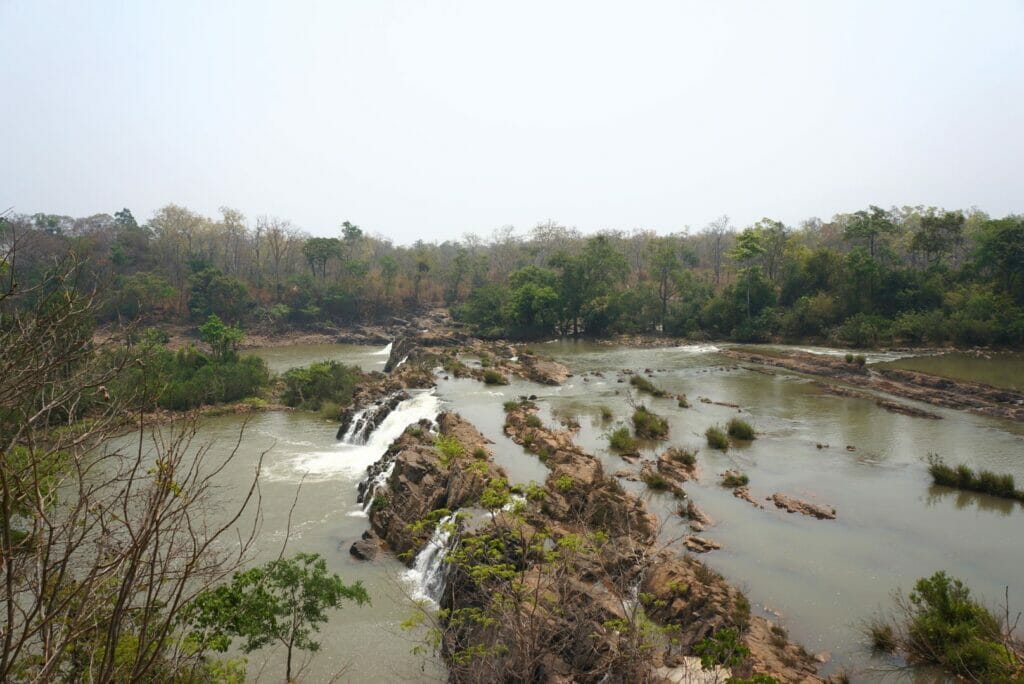
To tell you the truth, we had planned to go to the Tad Tayicseua waterfall and spend the night there. At the time, a big portion of the road was in a very bad state and we wanted to advance as much as possible on this not-very-cheerful part. Only, on the road towards Attapeu, we never found the intersection in the east which leads towards this waterfall. We thus came back to go to Tad Faek and to Tad Hua Gan and to sleep near. In the end, destiny made things rather well! We bathed there at the end of the afternoon and many children had fun in the water. All in all, a great time in their company!
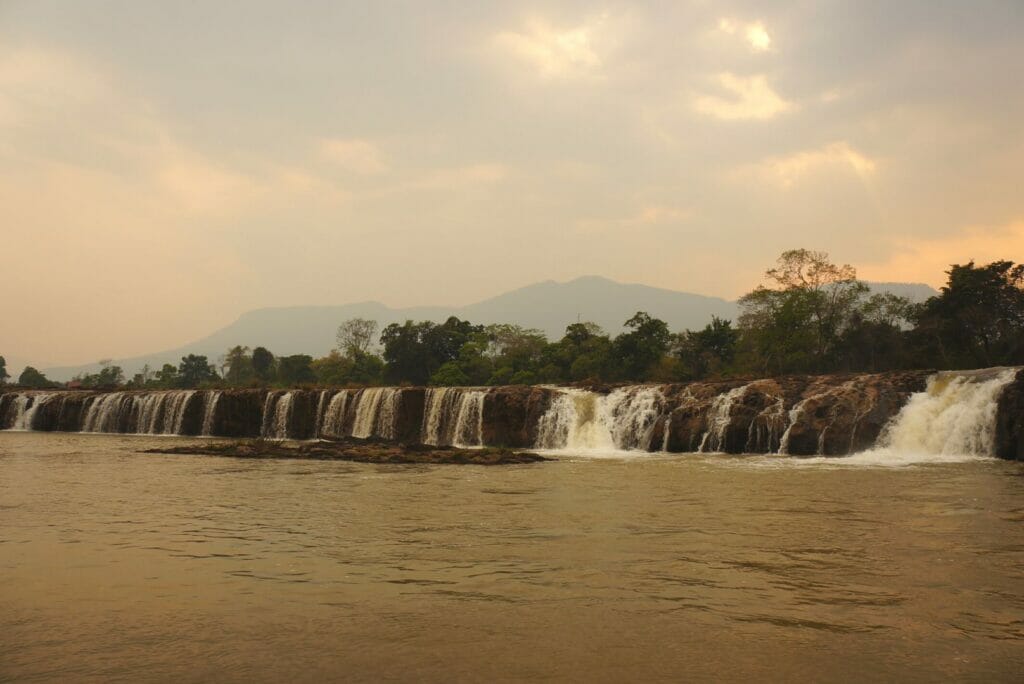
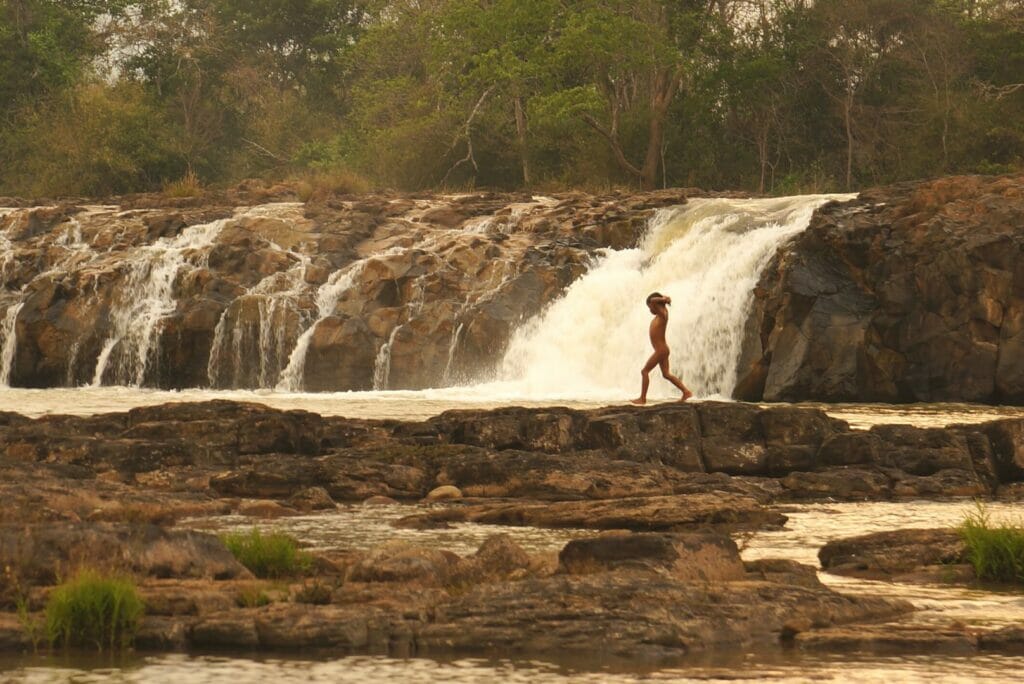
For the hotels, you have two possibilities. The first one is to stay around these two waterfalls (Tad Faek and Tad Houa Khon) like we did and sleep at the P&S Garden (they rent tents) or at the Thepsawanh guesthouse shortly before Tad Faek (120 000 kips the double room). The second option is then to move towards Tad Tayicseua and there you will find some guesthouses (Platinum or H Thida). In any case, it is better to knock on the door of the accommodation since they are not bookable online.
We talk about choice because there is no accommodation on the 35 km stretch between these two sites. However, since there are many points of interest in the last portion of the loop, we advise you to push on to Tad Tayicseua. This will save you time to enjoy longer the next day 😉.
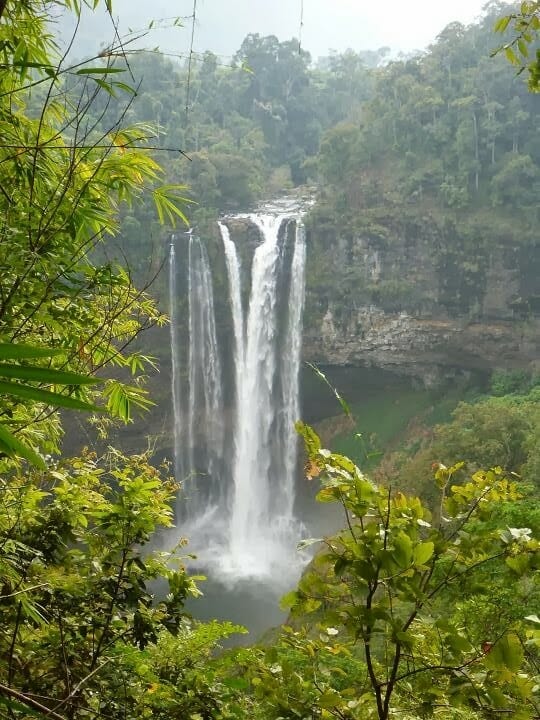
If you plan to sleep in Tad Tayicseua, don’t miss the Tad Katamtok waterfall (also called Nam Tok Katamtok or Tad Xekatam). It fights for the title of the highest waterfall in Laos with Tad Fane, another natural wonder of the Bolaven Plateau that you will not miss the next day!
Tad Katamtok is visible from the road and the only observation point is on the left, 2 km before the bridge and the dam. In short, we feel that we have passed to another level in terms of waterfalls and it is one of the most beautiful of the Pakse Loop!
Day 4: From Tad Tayicseua to Pakse (95 km)
This is the most beautiful part of this loop! This last day on the Bolaven Plateau promises an explosion of sublime waterfalls in the Dong Hua Sao National Protected Area. Moreover, this part of the road is absolutely beautiful: when we passed by, the coffee plantations were in bloom! It’s hard to concentrate on the road with such a show under the eyes…
You will notice it quite quickly in this last stage, but there are many coffee producers along the road and as many possible stops to sip the precious Laotian beverage… We are in another philosophy, a little far from the one of Mr. Vieng, Captain Hook and Samphone who just have their own land and produce a lesser quantity.
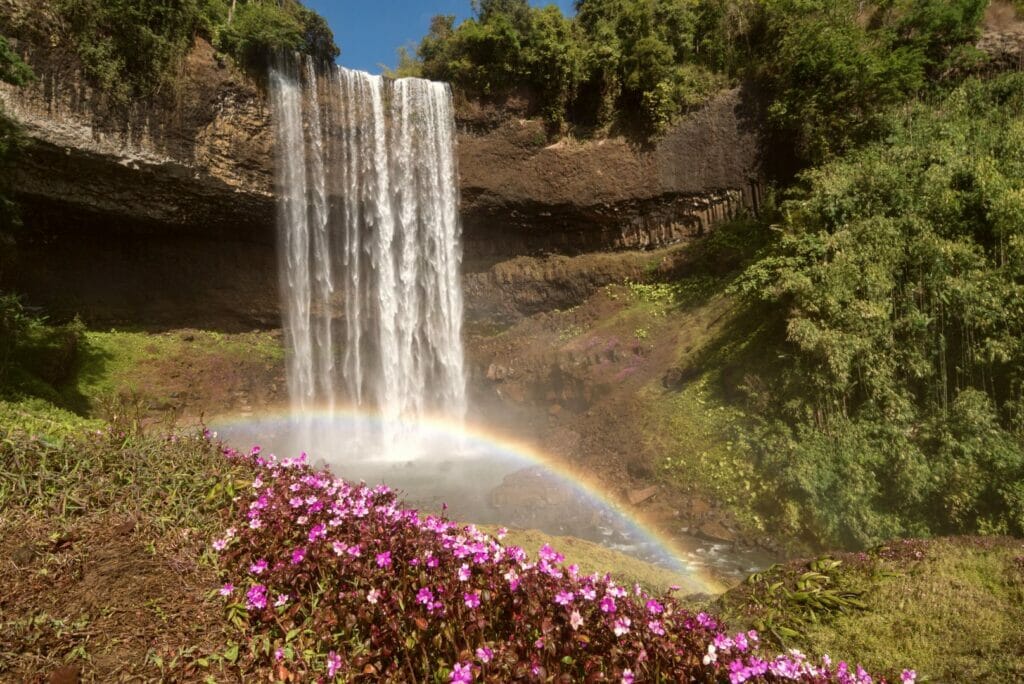
Tad Tayicseua
We begin the day with Tad Tayicseua, a beautiful set of waterfalls spread over two streams that flow into the river Xe Namnoy. Yes, it is not one but seven waterfalls that form one of the most popular sites of the Pakse Loop. There are only four of them accessible (in theory) but they alone are worth a visit. Park near the eponymous lookout (but don’t eat or sleep there, it’s expensive and not great) and walk 400 meters to the junction where the trails to the different waterfalls start. To walk around this series of waterfalls, keep in mind that it takes a good 2 or 3 hours and the trails are not flat. The most notable are:
- Tad Jarou Kiet Oak: beware, the terrain is steep and slippery to the foot of the waterfall but it is splendid in its green setting.
- Tad Jarou Halang: it is accessible after a flight of stairs and it is probably the most famous of the site! If the sun is shining, there is a good chance that a rainbow will form at its base. This adds a fairy-tale touch to this beautiful setting.
- Tad Jarou Thalaleui: a series of rapids perfect for a bite to eat or a swim in a very peaceful setting.
- Tad Jarou Maudren: another beautiful and powerful waterfall.
- Tad Tayicsua: a platform on the right gives a nice view of the top of the highest waterfall on the site. A path normally joins its base through the jungle but at your own risk!
We didn’t manage to find any map of Tad Tayicseua online except this one. If you have a map of the waterfalls to share, feel free to leave us a little comment 😉.
Tad Diew and Tad Koa
Continuing on the road to Tad Tayicsua, you will come across the Tad Diew waterfall but if you are a bit in a hurry, you can skip its visit. 1 km further, you have another nice waterfall, Tad Koa (or Tad Koo), but the whole area has been arranged for tourists which takes away some of its charms… Both are free.
Tad Yuang and Tad Fane
Once you have crossed Paksong, you will have on the way two of the most stunning waterfalls of the loop: Tad Yuang (Tad Gneuang on the signs) and Tad Fane. As they are close to Pakse, they are more frequented and more developed because some people do not do the whole loop of the Bolaven Plateau and prefer rather to make the trip during the day to see some tourist sites.
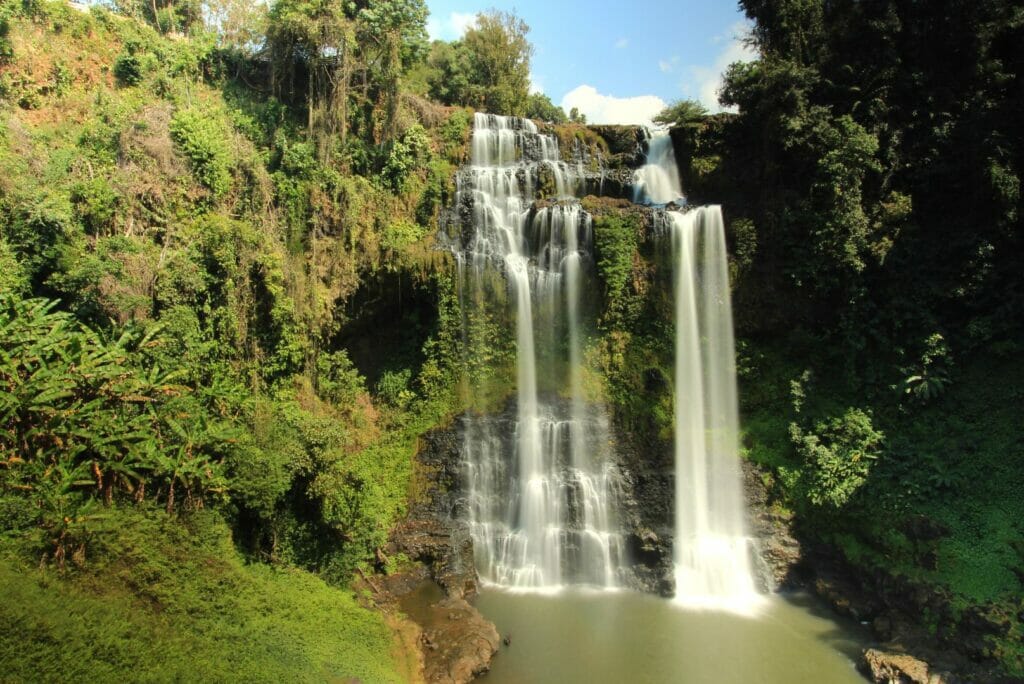
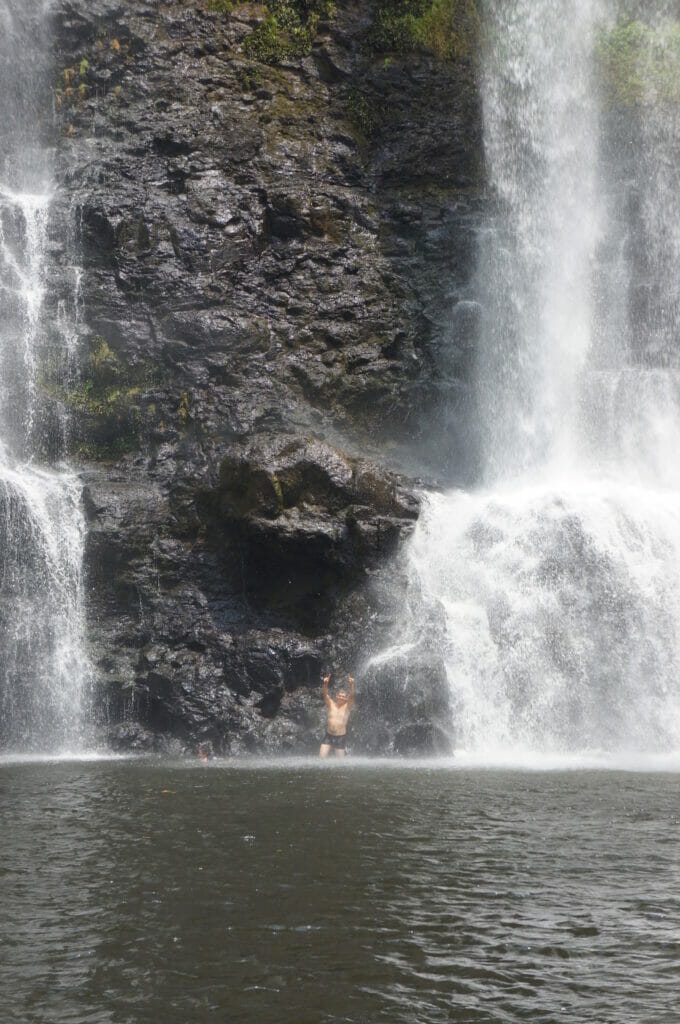
Separated by a path on 2 km, these two sites can be visited in one time to avoid you to pay 2 times 20 000 kips (for a ticket) per person and 2 times 5000 kips (the parking for the scooter). The waterfalls are sublime and impressive, especially Tad Fane whose two torrents flow from a cliff over 100 meters high! Is it the highest in Laos? It seems to be a bit higher than Tad Katamtok… To see it up close, a zip line is installed on both sides and the price is 40 $.
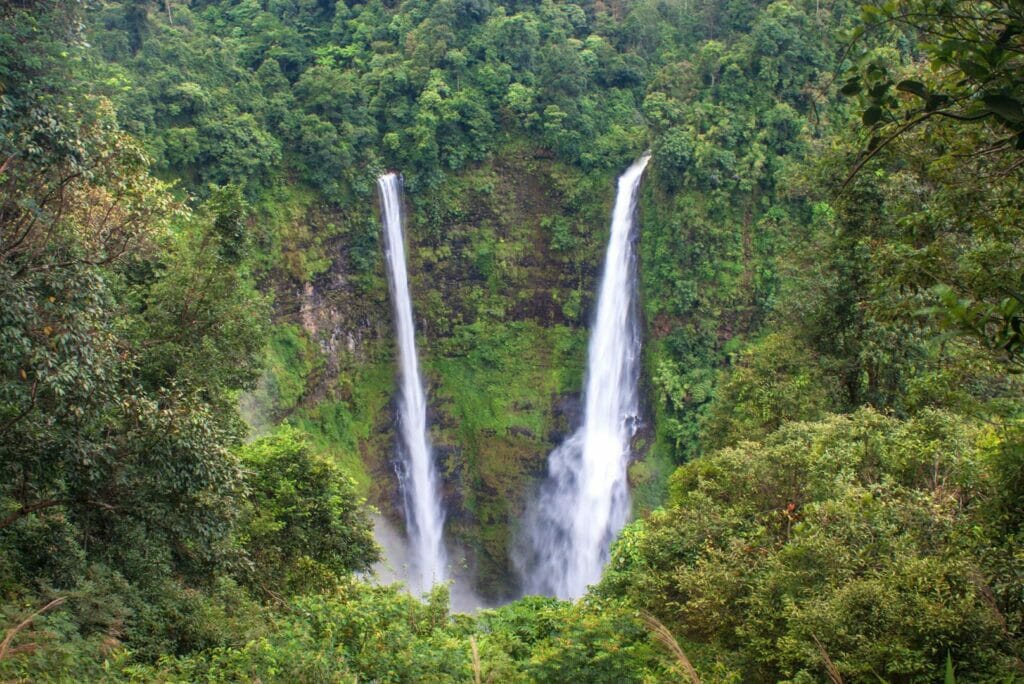
Tad Champee and Tad E-Tu
On the other side of the main road, you will see the last two waterfalls of this Pakse Loop: Tad Champi (or Champee, it’s number 2 if you follow well) and Tad E-Tu (or Itou).
The two roads to access the waterholes are two tracks that stretch for about 2 km through the coffee plantations. The entrance fee for Tad Champi is 10 000 kips per person and 5 000 kips for parking. Its particularity? The path takes you behind the water curtain and it’s a good spot for a swim! Tad E-Tu is in theory closed, but you can still pass by. As it is very similar to Tad Champee, it is worth going there if you are really a waterfall fan!
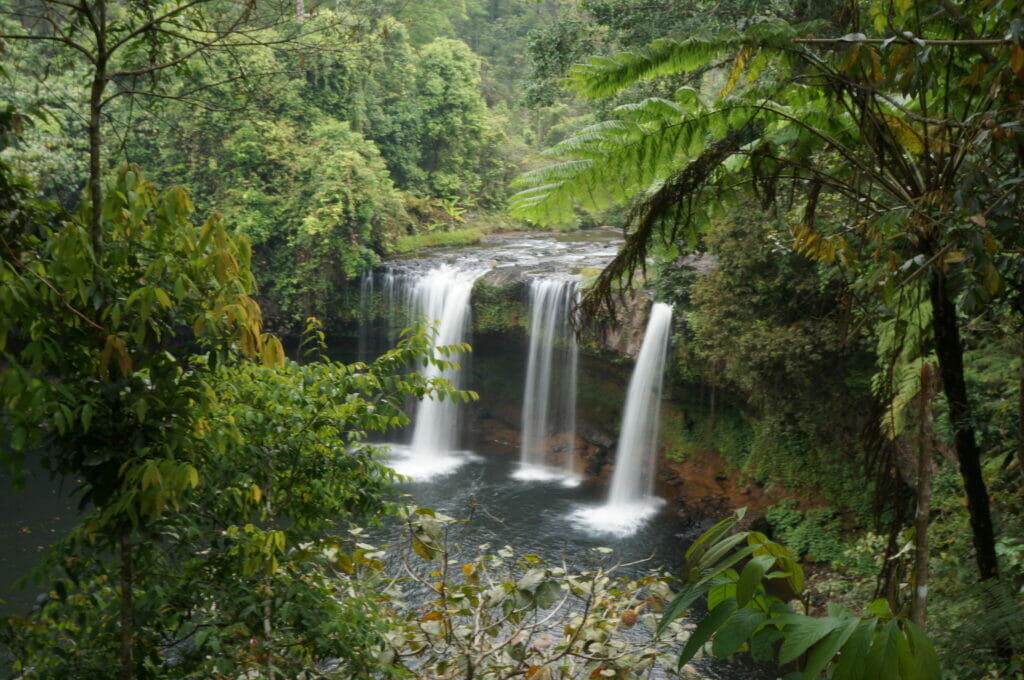
The useful information to read before making the Bolaven Plateau Loop
- Prefer the dry season to make the loop, between November and March. The rest of the year it is possible but the few tracks that lead to the waterfalls will be muddy and slippery as well as the paths…
- The small loop of Pakse is easily done in 2 days and the big loop in 3-4 days. You can also add an express passage to Champasak to visit Vat Phou at the end of your motorbike loop as indicated at the beginning of the article.
- Take long clothes that will protect you in case of a fall (it happens to anyone), the sun and the cooler temperatures that can prevail in some areas of the plateau.
- Bring sunscreen and mosquito repellent. Also, a small first aid kit can always be useful…
- Don’t forget your bathing suit for the waterfalls! For women, don’t forget to wear a sarong or something that covers you, as bikinis are not very accepted.
- Carry a spare bottle of gasoline with you. On many parts of the Bolaven Plateau Loop, there are very few gas stations and it could get you out of trouble.
- In Laos, parking lots are not free, which can be annoying in the long run, we admit it. However, paying a few kips is the insurance that nothing will happen to your two-wheeler! By the way, make sure that the motorcycle rental company lends you an anti-theft device and put it on at each stop.
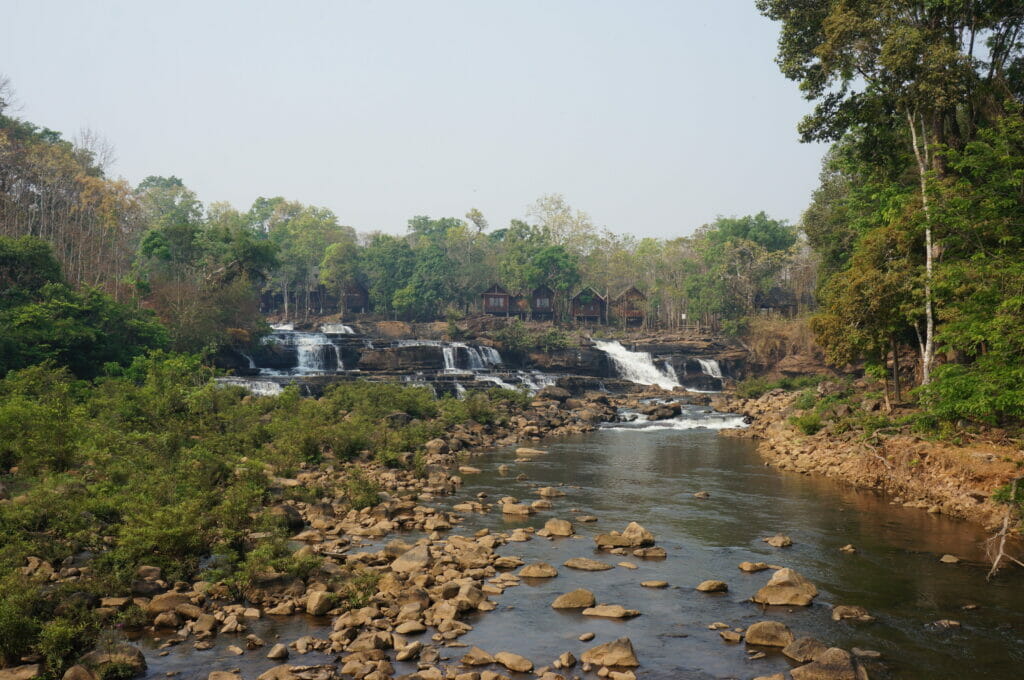
The Thakhek Loop or the Bolaven Plateau Loop?
Argh, this question is quite difficult! The two loops complement each other well: on one side, breathtaking karst landscapes and caves and on the other, an orgy of waterfalls in the middle of a luxuriant jungle… Well, OK, if we really had to choose, we would choose the Thakhek Loop rather than the Bolaven Plateau. We kept a nice memory of Konglor so… Basically, choosing is losing so do both 😉.
Now you know everything! Which loop tempts you the most? If you did both, don’t hesitate to tell us in the comments which one you preferred! Laos, it’s over for us… Before leaving for Indonesia, we’ll see you for the last article to complete the series!
See you!
Pin it
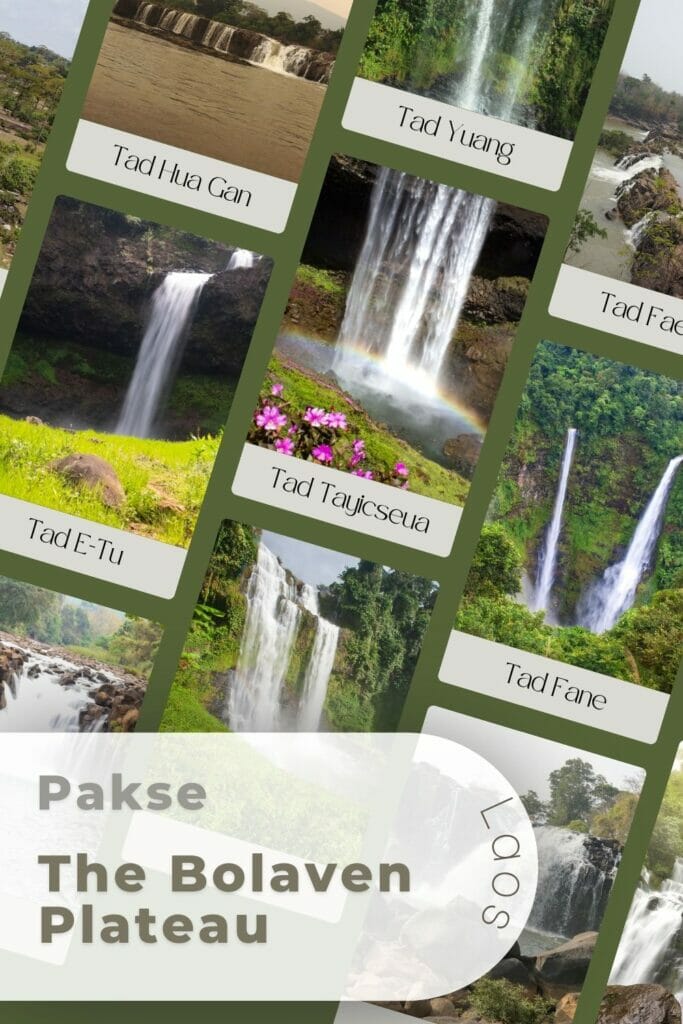
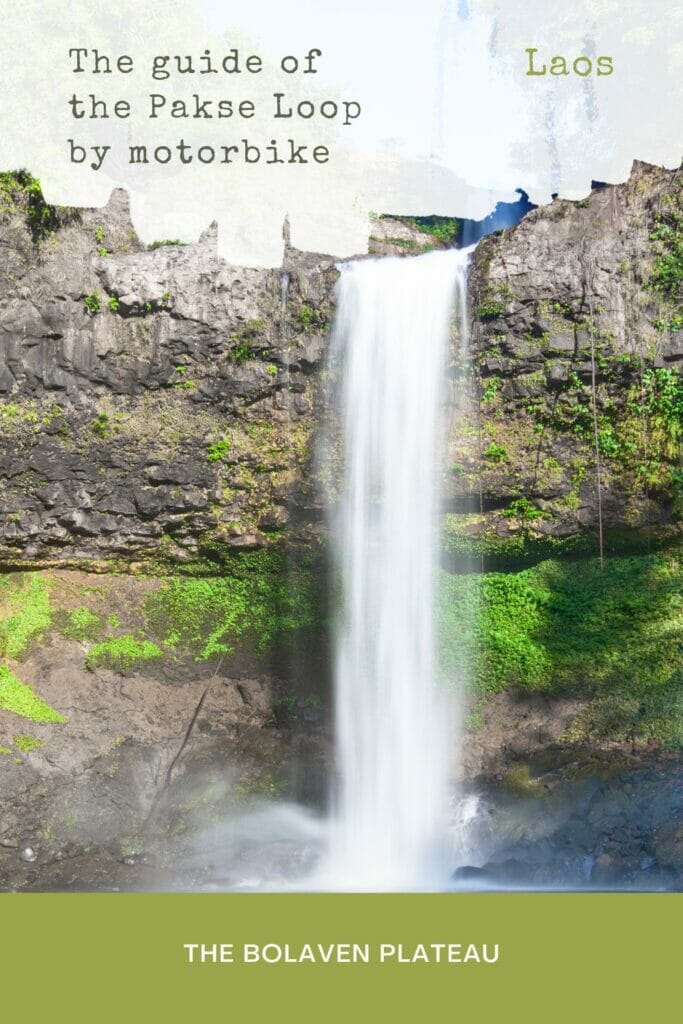
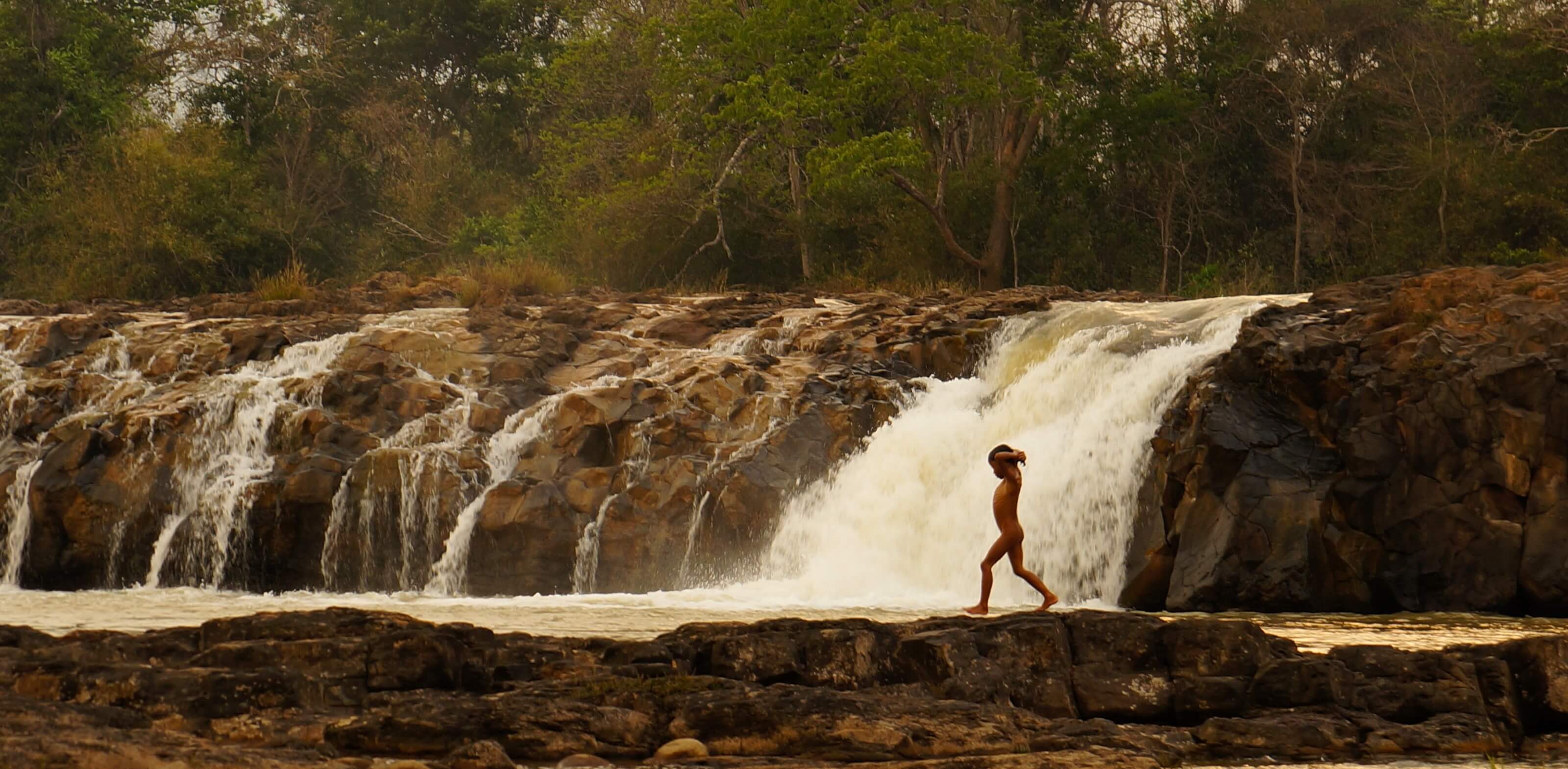
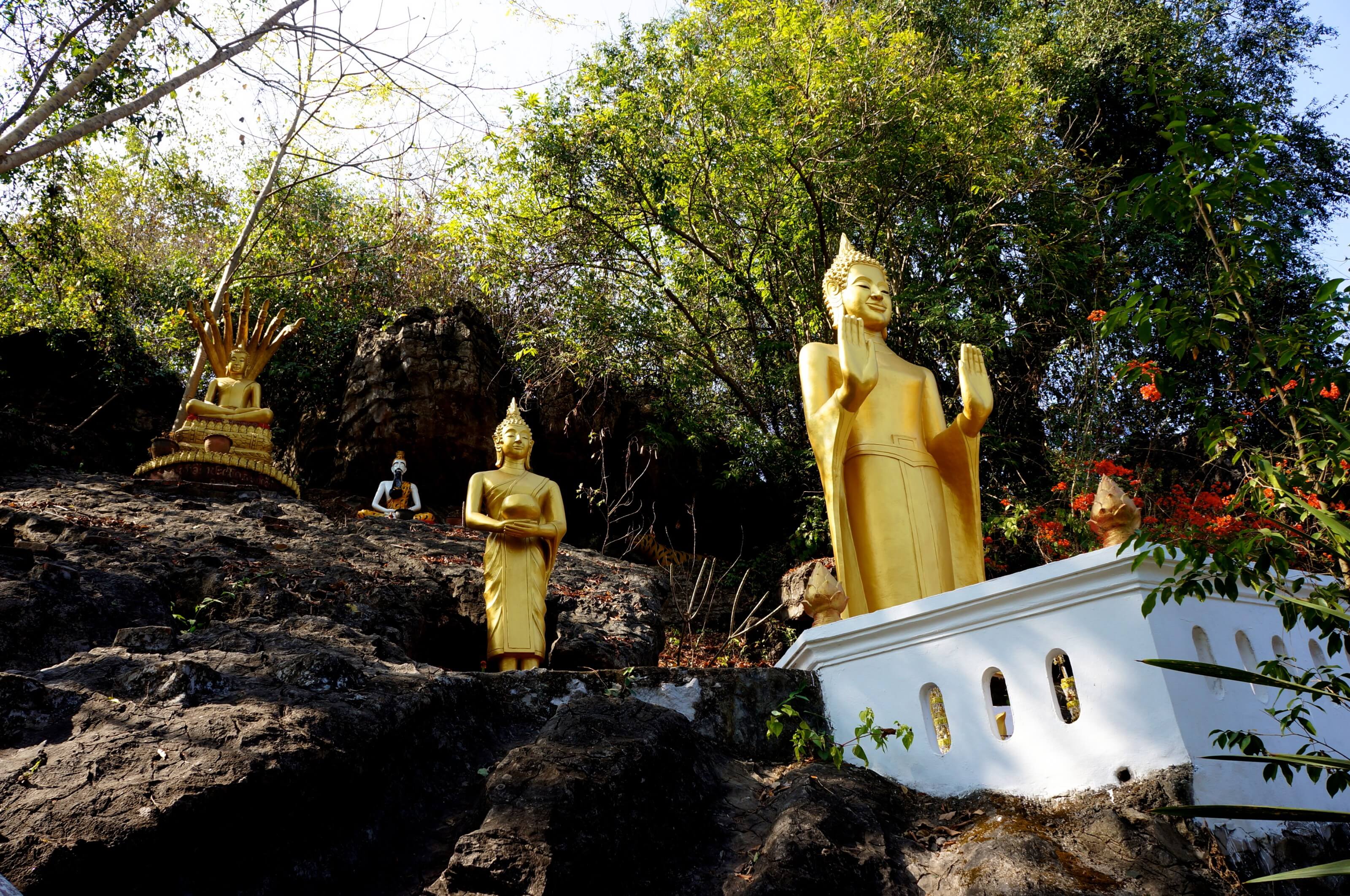
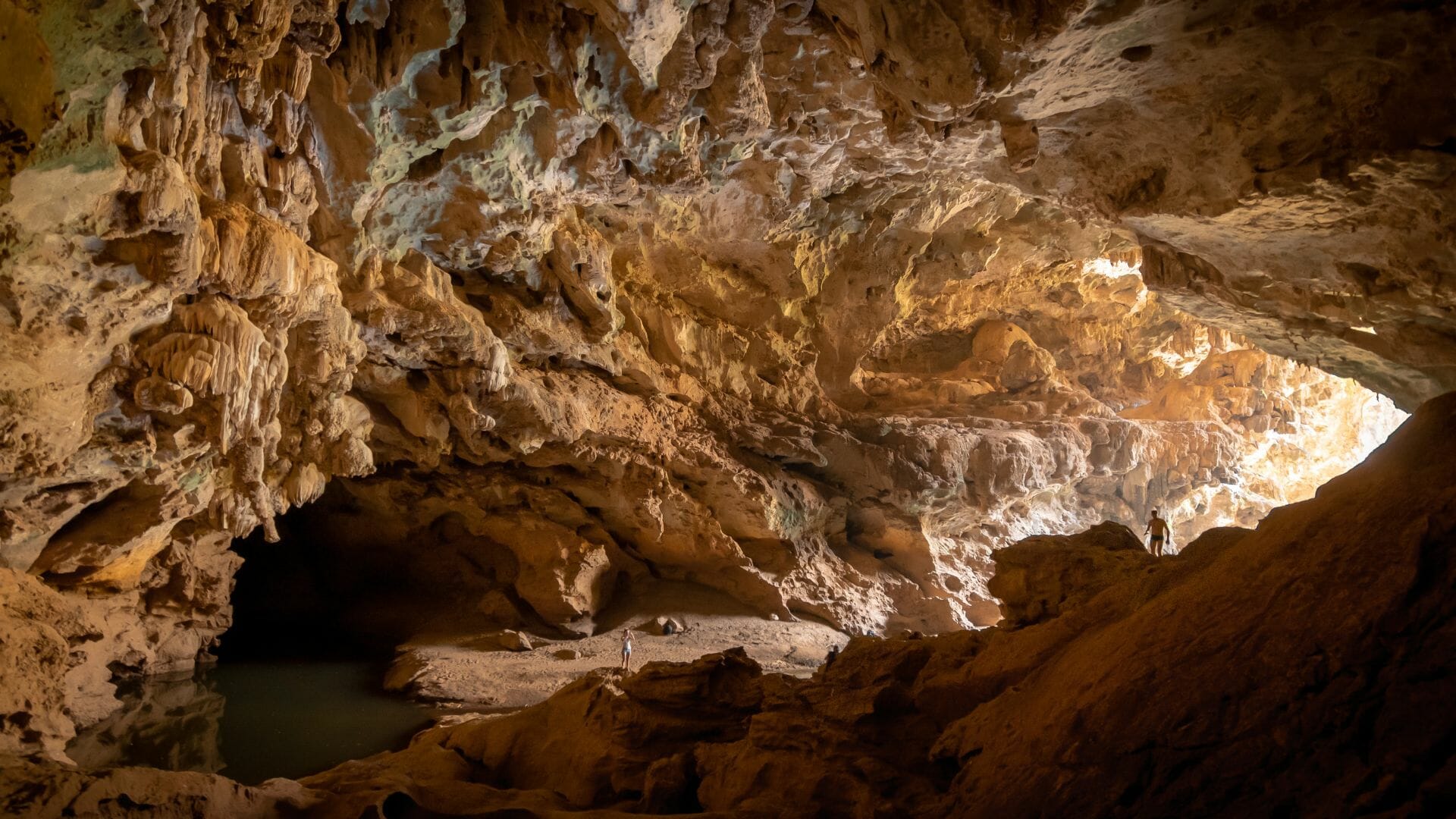
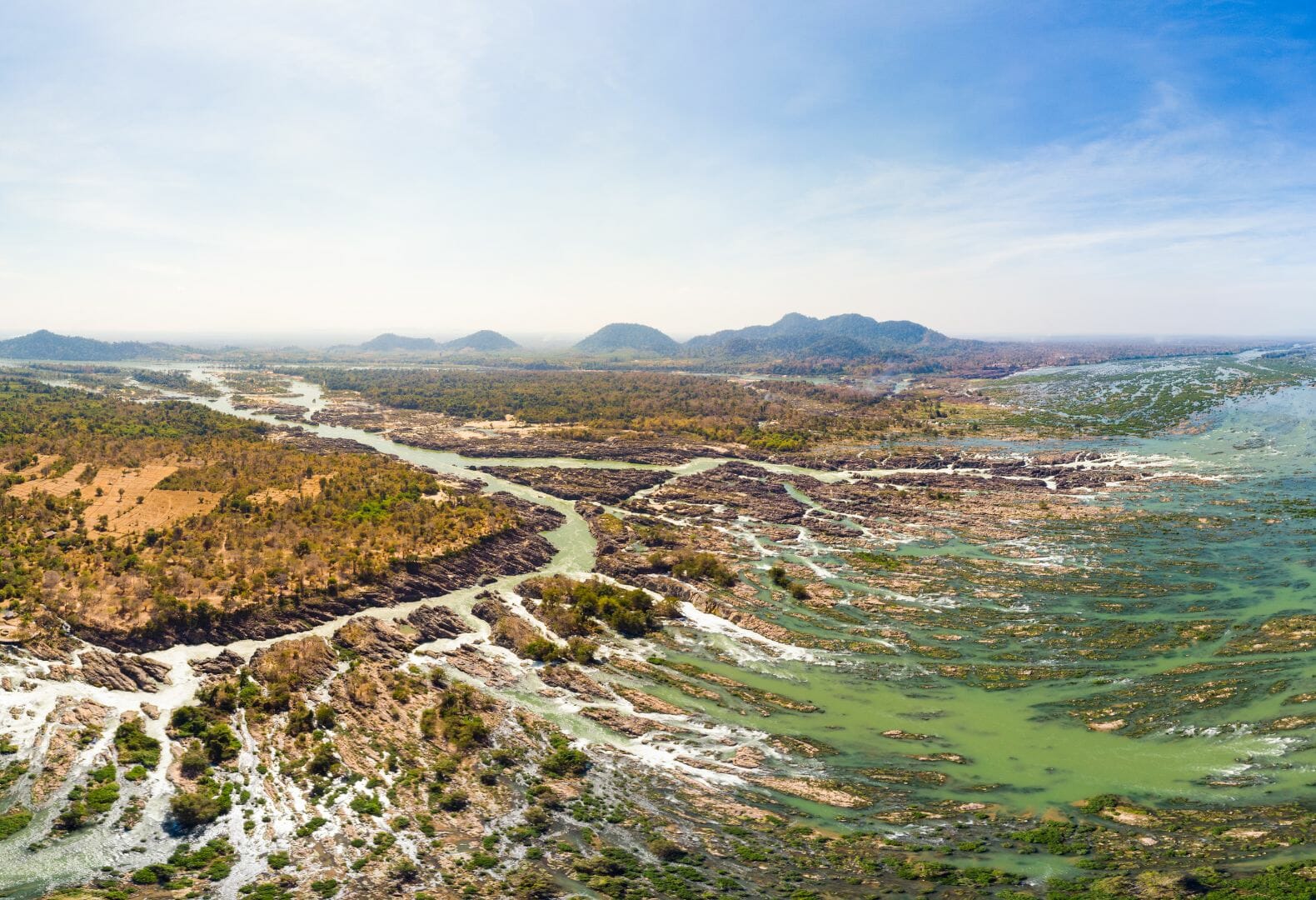
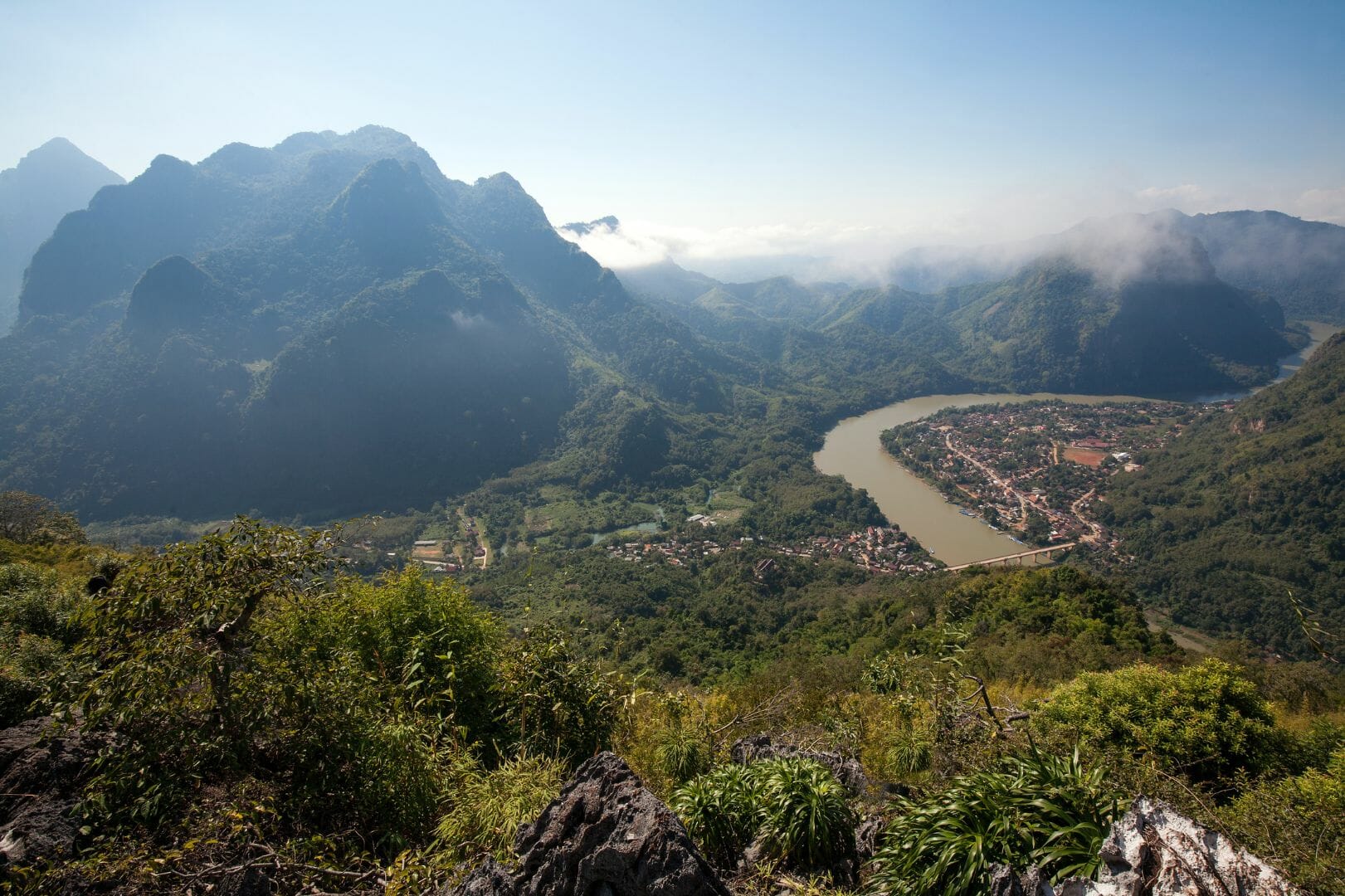
Hello, we noticed that you did the trip many years past. We have learned that the e16 is now paved and not very beautiful. Do you know anything about this?
Sorry Alicia we can’t help much more… but if it’s paved, it’s probably a good news 😉
Is possible to do the two loops in a car? pros? cons?